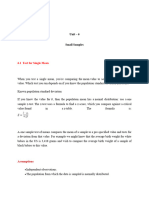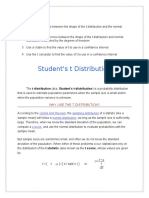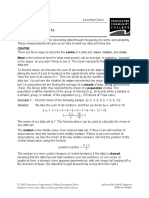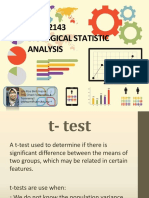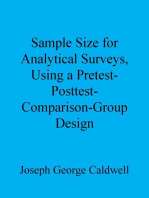Paired T Test
Paired T Test
Uploaded by
Muhamad Azhari MCopyright:
Available Formats
Paired T Test
Paired T Test
Uploaded by
Muhamad Azhari MOriginal Description:
Original Title
Copyright
Available Formats
Share this document
Did you find this document useful?
Is this content inappropriate?
Copyright:
Available Formats
Paired T Test
Paired T Test
Uploaded by
Muhamad Azhari MCopyright:
Available Formats
Statistics:
Rosie Shier. 2004.
1.1 Paired t-tests
Introduction
A paired t-test is used to compare two population means where you have two samples in which observations in one sample can be paired with observations in the other sample. Examples of where this might occur are: Before-and-after observations on the same subjects (e.g. students diagnostic test results before and after a particular module or course). A comparison of two dierent methods of measurement or two dierent treatments where the measurements/treatments are applied to the same subjects (e.g. blood pressure measurements using a stethoscope and a dynamap).
Procedure for carrying out a paired t-test
Suppose a sample of n students were given a diagnostic test before studying a particular module and then again after completing the module. We want to nd out if, in general, our teaching leads to improvements in students knowledge/skills (i.e. test scores). We can use the results from our sample of students to draw conclusions about the impact of this module in general. Let x = test score before the module, y = test score after the module To test the null hypothesis that the true mean dierence is zero, the procedure is as follows: 1. Calculate the dierence (di = yi xi ) between the two observations on each pair, making sure you distinguish between positive and negative dierences. . 2. Calculate the mean dierence, d 3. Calculate the standard deviation of the dierences, sd , and use this to calculate the sd ) = standard error of the mean dierence, SE (d n 4. Calculate the t-statistic, which is given by T = d ) . Under the null hypothesis, SE (d this statistic follows a t-distribution with n 1 degrees of freedom.
5. Use tables of the t-distribution to compare your value for T to the tn1 distribution. This will give the p-value for the paired t-test. 1
NOTE: For this test to be valid the dierences only need to be approximately normally distributed. Therefore, it would not be advisable to use a paired t-test where there were any extreme outliers. Example Using the above example with n = 20 students, the following results were obtained: Student Pre-module score 1 18 2 21 3 16 4 22 5 19 6 24 7 17 8 21 9 23 10 18 11 14 12 16 13 16 14 19 15 18 16 20 17 12 18 22 19 15 20 17 Post-module Dierence score 22 +4 25 +4 17 +1 24 +2 16 -3 29 +5 20 +3 23 +2 19 -4 20 +2 15 +1 15 -1 18 +2 26 +7 18 0 24 +4 18 +6 25 +3 19 +4 16 -1
Calculating the mean and standard deviation of the dierences gives: sd = 2 .837 = 0.634 = 2.05 and sd = 2.837. Therefore, SE (d ) = d n 20 So, we have: 2.05 = 3.231 on 19 df 0.634 Looking this up in tables gives p = 0.004. Therefore, there is strong evidence that, on average, the module does lead to improvements. t=
Condence interval for the true mean dierence
The in above example the estimated average improvement is just over 2 points. Note that although this is statistically signicant, it is actually quite a small increase. It would be useful to calculate a condence interval for the mean dierence to tell us within what limits the true dierence is likely to lie. A 95% condence interval for the true mean dierence is: sd t d n (t SE (d )) or, equivalently d
where t is the 2.5% point of the t-distribution on n 1 degrees of freedom. Using our example: We have a mean dierence of 2.05. The 2.5% point of the t-distribution with 19 degrees of freedom is 2.093. The 95% condence interval for the true mean dierence is therefore: 2.05 (2.093 0.634) = 2.05 1.33 = (0.72, 3.38) This conrms that, although the dierence in scores is statistically signicant, it is actually relatively small. We can be 95% sure that the true mean increase lies somewhere between just under one point and just over 3 points.
Carrying out a paired t-test in SPSS
The simplest way to carry out a paired t-test in SPSS is to compute the dierences (using Transform, Compute) and then carrying out a one-sample t-test as follows: Analyze Compare Means One-Sample T Test Choose the dierence variable as the Test Variable and click OK The output will look like this: One-Sample Statistics N Mean Std. Deviation Std. Error Mean 20 2.0500 2.83725 .63443 One-Sample Test Test Value = 0 95% Condence Interval t df Sig. (2-tailed) Mean Dierence Lower Upper 3.231 19 .004 2.0500 .7221 3.3779
Dierence
Dierence
You might also like
- Practical Engineering, Process, and Reliability StatisticsFrom EverandPractical Engineering, Process, and Reliability StatisticsNo ratings yet
- Standardised Effect Size in Mixed ML ModelsDocument9 pagesStandardised Effect Size in Mixed ML ModelsSergio Enrique Mora MojicaNo ratings yet
- BADM 572 - Stats Homework Answers 6Document7 pagesBADM 572 - Stats Homework Answers 6nicktimmonsNo ratings yet
- T DistributionDocument4 pagesT DistributionEr Rajesh BuraNo ratings yet
- Examples Biostatistics. FinalDocument90 pagesExamples Biostatistics. FinalabdihakemNo ratings yet
- Lesson 23: Tests of Hypotheses - Small SamplesDocument5 pagesLesson 23: Tests of Hypotheses - Small SamplesWinny Shiru MachiraNo ratings yet
- To Prepare and Validate Instrument in ResearchDocument12 pagesTo Prepare and Validate Instrument in ResearchAchmad MuttaqienNo ratings yet
- Assignment Updated 101Document24 pagesAssignment Updated 101Lovely Posion100% (1)
- Regression AnalysisDocument68 pagesRegression AnalysisTewabeNo ratings yet
- Measure of Central TendencyDocument40 pagesMeasure of Central TendencybmNo ratings yet
- CLG Project ReportDocument13 pagesCLG Project Reportruchi sharmaNo ratings yet
- Statistics: 1.1 Paired T-Tests: Rosie Shier. 2004Document3 pagesStatistics: 1.1 Paired T-Tests: Rosie Shier. 2004Mohamed NaeimNo ratings yet
- Edur 8131 Notes 5 T TestDocument23 pagesEdur 8131 Notes 5 T TestNazia SyedNo ratings yet
- 04 Simple AnovaDocument9 pages04 Simple AnovaShashi KapoorNo ratings yet
- 6.1 Test For Single Mean: AssumptionsDocument17 pages6.1 Test For Single Mean: AssumptionsSAROJ KUMARNo ratings yet
- X X X X N X N: 1. Discuss/define Three Measures of Central TendencyDocument7 pagesX X X X N X N: 1. Discuss/define Three Measures of Central TendencyPandurang ThatkarNo ratings yet
- Chen10011 NotesDocument58 pagesChen10011 NotesTalha TanweerNo ratings yet
- Group 8 (Semblante, Lague, Peras, Rama) T-Test: ValueDocument11 pagesGroup 8 (Semblante, Lague, Peras, Rama) T-Test: Valueinah krizia lagueNo ratings yet
- Lesson 3 - T-Distribution (Module)Document26 pagesLesson 3 - T-Distribution (Module)charmaine marasigan100% (1)
- CAPE - Module 2 - Uncertainty in MeasurmentsDocument9 pagesCAPE - Module 2 - Uncertainty in MeasurmentsMike AuxlongNo ratings yet
- Problem 1: T Distribution CalculatorDocument7 pagesProblem 1: T Distribution CalculatorJoe ChalhoubNo ratings yet
- The Objective of Design of ExperimentsDocument26 pagesThe Objective of Design of Experimentssreeramsp6No ratings yet
- Dependent T TestDocument38 pagesDependent T TestRatna Monika SariNo ratings yet
- Costructs T Distribution (Dianne)Document9 pagesCostructs T Distribution (Dianne)Dianne RuizNo ratings yet
- 2 Mean Median Mode VarianceDocument29 pages2 Mean Median Mode VarianceBonita Mdoda-ArmstrongNo ratings yet
- Carrying_out_investigations___writing_lab_reports_-_Criterion_CDocument27 pagesCarrying_out_investigations___writing_lab_reports_-_Criterion_Csecretman141414No ratings yet
- Describing Data: Centre Mean Is The Technical Term For What Most People Call An Average. in Statistics, "Average"Document4 pagesDescribing Data: Centre Mean Is The Technical Term For What Most People Call An Average. in Statistics, "Average"Shane LambertNo ratings yet
- Day 13 - Intro To T StatisticDocument7 pagesDay 13 - Intro To T StatisticLianne SedurifaNo ratings yet
- t-test_20241107_051452_0000Document17 pagest-test_20241107_051452_0000nicolebalaong7No ratings yet
- Inferential Statistic IIDocument61 pagesInferential Statistic IIThiviyashiniNo ratings yet
- SPE401 Fall 2021 638098030273820341Document22 pagesSPE401 Fall 2021 638098030273820341Kb AliNo ratings yet
- Some Basic Null Hypothesis TestsDocument19 pagesSome Basic Null Hypothesis TestsSudhir JainNo ratings yet
- Lecture 2Document26 pagesLecture 2Moamen MohamedNo ratings yet
- Statistical Analysis 3: Paired T-Test: Research Question TypeDocument4 pagesStatistical Analysis 3: Paired T-Test: Research Question TypeRetno Tri Astuti RamadhanaNo ratings yet
- Week 7: The T Distribution, Confidence Intervals and TestsDocument51 pagesWeek 7: The T Distribution, Confidence Intervals and TestsHussein RazaqNo ratings yet
- Measures of Central Tendency, Dispersion and ShapeDocument10 pagesMeasures of Central Tendency, Dispersion and Shapesiwaleniza42No ratings yet
- Technical Report: Detecting Influential Data in DEA: 1 The Measure of InfluenceDocument11 pagesTechnical Report: Detecting Influential Data in DEA: 1 The Measure of InfluenceAndy JohnsonNo ratings yet
- Non Parametric Test-1Document26 pagesNon Parametric Test-1megspandiNo ratings yet
- Statistics Presentation 7Document55 pagesStatistics Presentation 7umutkose.eduNo ratings yet
- An Introduction To T-Tests: Statistical Test Means Hypothesis TestingDocument8 pagesAn Introduction To T-Tests: Statistical Test Means Hypothesis Testingshivani100% (1)
- Lesson 14 - Hypothesis Testing Independent Samples: Return To Cover PageDocument4 pagesLesson 14 - Hypothesis Testing Independent Samples: Return To Cover PagezaenalkmiNo ratings yet
- Introduction To Statistics - 2023-2024Document38 pagesIntroduction To Statistics - 2023-2024Jaireh GonzalesNo ratings yet
- Comparison of ResultsDocument6 pagesComparison of Resultsodubade opeyemiNo ratings yet
- Analysis Interpretation and Use of Test DataDocument50 pagesAnalysis Interpretation and Use of Test DataJayson EsperanzaNo ratings yet
- Chapt3 OverheadsDocument8 pagesChapt3 OverheadsGouri DasNo ratings yet
- Hypothesis Testing - Online - Lecture - 3Document15 pagesHypothesis Testing - Online - Lecture - 3namit sharmaNo ratings yet
- T Test For Independent SamplesDocument29 pagesT Test For Independent SamplesRichard BacharNo ratings yet
- Bio Statistics 3Document13 pagesBio Statistics 3Moos LightNo ratings yet
- Unit FiveDocument16 pagesUnit Fivetekleab71221No ratings yet
- Inference About A Population MeanDocument19 pagesInference About A Population Mean1ab4cNo ratings yet
- MODULE 9 Anova BSADocument10 pagesMODULE 9 Anova BSAJevelyn Mendoza FarroNo ratings yet
- Unit IV. Inferential Statistics: A. T-Test B. Analysis of Variance (ANOVA) C. Chi-SquareDocument26 pagesUnit IV. Inferential Statistics: A. T-Test B. Analysis of Variance (ANOVA) C. Chi-SquareDave ReyesNo ratings yet
- Stat ExamDocument21 pagesStat Exampizza.bubbles.007No ratings yet
- Statistics - Chapter-11Document28 pagesStatistics - Chapter-11Imranul HoqueNo ratings yet
- One Sample Hypothesis TestingDocument29 pagesOne Sample Hypothesis TestingAnastasiaNo ratings yet
- 20 Twosamp 4thDocument12 pages20 Twosamp 4thPunita RaniNo ratings yet
- Ifp 20-21 PNS1 Unit9 Ce01 LiveworkshopDocument44 pagesIfp 20-21 PNS1 Unit9 Ce01 Liveworkshopwepifo5630No ratings yet
- Sample Size for Analytical Surveys, Using a Pretest-Posttest-Comparison-Group DesignFrom EverandSample Size for Analytical Surveys, Using a Pretest-Posttest-Comparison-Group DesignNo ratings yet
- GCSE Maths Revision: Cheeky Revision ShortcutsFrom EverandGCSE Maths Revision: Cheeky Revision ShortcutsRating: 3.5 out of 5 stars3.5/5 (2)














